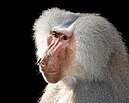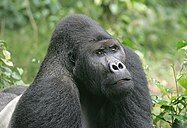Primate
| Primates Temporal range:
Early Paleocene to Present | |
|---|---|
| Scientific classification | |
| Domain: | Eukaryota |
| Kingdom: | Animalia |
| Phylum: | Chordata |
| Class: | Mammalia |
| Mirorder: | Primatomorpha |
| Order: | Primates Linnaeus, 1758[1] |
| Suborders | |
|
sister: Dermoptera
| |

| |
| Range and density of non-human primates. | |
| Synonyms | |
|
cladistically including crown primates[2] )
| |
Primates are the members of a diverse
Primates have large brains (relative to body size) compared to other mammals, as well as an increased reliance on visual acuity at the expense of the sense of
Primates are among the most social of animals, forming pairs or family groups, uni-male harems, and multi-male/multi-female groups. Non-human primates have at least four types of
Close interactions between humans and non-human primates (NHPs) can create opportunities for the transmission of
Etymology
The English name primates is derived from Old French or French primat, from a noun use of Latin primat-, from primus ('prime, first rank').[3] The name was given by Carl Linnaeus because he thought this the "highest" order of animals.[4] The relationships among the different groups of primates were not clearly understood until relatively recently, so the commonly used terms are somewhat confused. For example, ape has been used either as an alternative for monkey or for any tailless, relatively human-like primate.[5][6]
Sir
In contrast with Clark's methodology, modern classifications typically identify (or name) only those groupings that are
The cladogram below shows one possible classification sequence of the living primates:[10][11] groups that use common (traditional) names are shown on the right.
|
prosimians
monkeys
lesser apes
great apes |
All groups with scientific names are clades, or monophyletic groups, and the sequence of scientific classification reflects the evolutionary history of the related lineages. Groups that are traditionally named are shown on the right; they form an "ascending series" (per Clark, see above), and several groups are paraphyletic:
- Prosimians contain two monophyletic groups (the suborder Strepsirrhini, or lemurs, lorises and allies, as well as the tarsiers of the suborder Haplorhini); it is a paraphyletic grouping because it excludes the Simiiformes, which also are descendants of the common ancestor Primates.
- Monkeys comprise two monophyletic groups, New World monkeys and Old World monkeys, but is paraphyletic because it excludes hominoids, superfamily Hominoidea, also descendants of the common ancestor Simiiformes.
- Apes as a whole, and the great apes, are paraphyletic if the terms are used such that they exclude humans.
Thus, the members of the two sets of groups, and hence names, do not match, which causes problems in relating scientific names to common (usually traditional) names. Consider the superfamily Hominoidea: In terms of the common names on the right, this group consists of apes and humans and there is no single common name for all the members of the group. One remedy is to create a new common name, in this case hominoids. Another possibility is to expand the use of one of the traditional names. For example, in his 2005 book, the
As of 2021[update], there is no consensus as to whether to accept traditional (that is, common), but paraphyletic, names or to use monophyletic names only; or to use 'new' common names or adaptations of old ones. Both competing approaches can be found in biological sources, often in the same work, and sometimes by the same author. Thus, Benton defines apes to include humans, then he repeatedly uses ape-like to mean 'like an ape rather than a human'; and when discussing the reaction of others to a new fossil he writes of "claims that Orrorin ... was an ape rather than a human".[13]
Classification of living primates
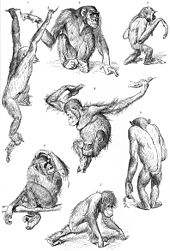

A list of the families of the living primates is given below, together with one possible classification into ranks between order and family.[1][10][14][15] Other classifications are also used. For example, an alternative classification of the living Strepsirrhini divides them into two infraorders, Lemuriformes and Lorisiformes.[16]
- Order Primates
- Suborder Strepsirrhini: lemurs, galagos and lorisids
- Infraorder Lemuriformes[a]
- Superfamily Lemuroidea
- Family Cheirogaleidae: dwarf lemurs and mouse-lemurs (41 species)
- Family Daubentoniidae: aye-aye (1 species)
- Family Lemuridae: ring-tailed lemur and allies (21 species)
- Family Lepilemuridae: sportive lemurs (26 species)
- Family Indriidae: woolly lemurs and allies (19 species)
- Superfamily Lorisoidea
- Family Lorisidae: lorisids (16 species)
- Family Galagidae: galagos (23 species)
- Superfamily
- Infraorder Lemuriformes[a]
- Suborder Haplorhini: tarsiers, monkeys and apes
- Infraorder Tarsiiformes
- Family Tarsiidae: tarsiers (14 species)
- Infraorder Simiiformes(or Anthropoidea)
- Parvorder Platyrrhini: New World monkeys
- Family Callitrichidae: marmosets and tamarins (49 species)
- Family Cebidae: capuchins and squirrel monkeys (29 species)
- Family Aotidae: night or owl monkeys (douroucoulis) (11 species)
- Family Pitheciidae: titis, sakis and uakaris (56 species)
- Family Atelidae: howler, spider, woolly spider and woolly monkeys (26 species)
- Parvorder Catarrhini
- Superfamily Cercopithecoidea
- Family Cercopithecidae: Old World monkeys (165 species)
- Superfamily Hominoidea
- Family Hylobatidae: gibbons or "lesser apes" (20 species)
- Family Hominidae: great apes, including humans (8 species)
- Family
- Superfamily Cercopithecoidea
- Parvorder
- Infraorder Tarsiiformes
- Suborder Strepsirrhini: lemurs, galagos and lorisids
Order Primates was established by
Before Anderson and Jones introduced the classification of Strepsirrhini and Haplorhini in 1984,
Phylogeny and genetics
|
Order Primates is part of the clade Euarchontoglires, which is nested within the clade Eutheria of Class Mammalia. Recent molecular genetic research on primates, colugos, and treeshrews has shown that the two species of colugos are more closely related to primates than to treeshrews,[25] even though treeshrews were at one time considered primates.[26] These three orders make up the clade Euarchonta. The combination of this clade with the clade Glires (composed of Rodentia and Lagomorpha) forms the clade Euarchontoglires. Variously, both Euarchonta and Euarchontoglires are ranked as superorders. Some scientists consider Dermoptera to be a suborder of Primates and use the suborder Euprimates for the "true" primates.[27]
Evolutionary history
The primate lineage is thought to go back at least near the
By modern
According to genetic studies, the lemurs of Madagascar diverged from the lorisoids approximately 75 mya.
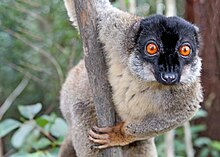
Until recently, the aye-aye has been difficult to place within Strepsirrhini.[1] Theories had been proposed that its family, Daubentoniidae, was either a lemuriform primate (meaning its ancestors split from the lemur line more recently than lemurs and lorises split) or a sister group to all the other strepsirrhines. In 2008, the aye-aye family was confirmed to be most closely related to the other Malagasy lemurs, likely having descended from the same ancestral population that colonized the island.[42]
Suborder
As in the case of lemurs, the origin of New World monkeys is unclear. Molecular studies of concatenated nuclear sequences have yielded a widely varying estimated date of divergence between platyrrhines and catarrhines, ranging from 33 to 70 mya, while studies based on mitochondrial sequences produce a narrower range of 35 to 43 mya.
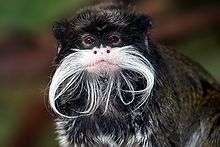
Apes and monkeys spread from Africa into Europe and Asia starting in the Miocene.[57] Soon after, the lorises and tarsiers made the same journey. The first hominin fossils were discovered in northern Africa and date back 5–8 mya.[44] Old World monkeys disappeared from Europe about 1.8 mya.[58] Molecular and fossil studies generally show that modern humans originated in Africa 100,000–200,000 years ago.[59]
Although primates are well studied in comparison to other animal groups, several new species have
Hybrids
Primate hybrids usually arise in captivity,[61] but there have also been examples in the wild.[62][63] Hybridization occurs where two species' range overlap to form hybrid zones; hybrids may be created by humans when animals are placed in zoos or due to environmental pressures such as predation.[62] Intergeneric hybridizations, hybrids of different genera, have also been found in the wild. Although they belong to genera that have been distinct for several million years, interbreeding still occurs between the gelada and the hamadryas baboon.[64]
Clones
On 24 January 2018, scientists in China reported in the journal Cell the creation of two crab-eating macaque clones, named Zhong Zhong and Hua Hua, using the complex DNA transfer method that produced Dolly the sheep, for the first time.[65][66][67][68][69]
Anatomy and physiology
Head
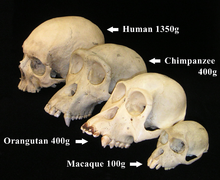
The primate skull has a large, domed
Primates have forward-facing eyes on the front of the skull;

Primates show an evolutionary trend towards a reduced
Body

Primates generally have five digits on each limb (
The primate
Sexual dimorphism
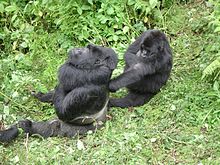
Comparative analyses have generated a more complete understanding of the relationship between
Locomotion
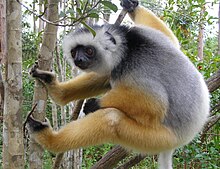
Primate species move by
Vision
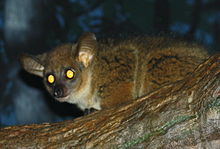
The evolution of color vision in primates is unique among most eutherian mammals. While the remote vertebrate ancestors of the primates possessed three color vision (trichromaticism), the nocturnal, warm-blooded, mammalian ancestors lost one of three cones in the retina during the Mesozoic era. Fish, reptiles and birds are therefore trichromatic or tetrachromatic, while all mammals, with the exception of some primates and marsupials,[95] are dichromats or monochromats (totally color blind).[78] Nocturnal primates, such as the night monkeys and bush babies, are often monochromatic. Catarrhines are routinely trichromatic due to a gene duplication of the red-green opsin gene at the base of their lineage, 30 to 40 million years ago.[78][96] Platyrrhines, on the other hand, are trichromatic in a few cases only.[97] Specifically, individual females must be heterozygous for two alleles of the opsin gene (red and green) located on the same locus of the X chromosome.[78] Males, therefore, can only be dichromatic, while females can be either dichromatic or trichromatic. Color vision in strepsirrhines is not as well understood; however, research indicates a range of color vision similar to that found in platyrrhines.[78]
Like catarrhines, howler monkeys (a family of platyrrhines) show routine trichromatism that has been traced to an evolutionarily recent gene duplication.[98] Howler monkeys are one of the most specialized leaf-eaters of the New World monkeys; fruits are not a major part of their diets,[93] and the type of leaves they prefer to consume (young, nutritive, and digestible) are detectable only by a red-green signal. Field work exploring the dietary preferences of howler monkeys suggests that routine trichromaticism was selected by environment.[97]
Behavior
Social systems
Richard Wrangham stated that social systems of primates are best classified by the amount of movement by females occurring between groups.[99] He proposed four categories:
- Female transfer systems – females move away from the group in which they were born. Females of a group will not be closely related whereas males will have remained with their natal groups, and this close association may be influential in social behavior. The groups formed are generally quite small.[99] This organization can be seen in chimpanzees, where the males, who are typically related, will cooperate in defense of the group's territory.[100] Evidence of this social system has also been found among Neanderthal remains in Spain[101] and in remains of Australopithecus and Paranthropus robustus groups in southern Africa.[102][103] Among New World Monkeys, spider monkeys and muriquis use this system.[104]

- Male transfer systems – while the females remain in their natal groups, the males will emigrate as adolescents. Polygynous and multi-male societies are classed in this category. Group sizes are usually larger.[99] This system is common among the ring-tailed lemur, capuchin monkeys and cercopithecine monkeys.[58]
- Monogamous species – a male–female bond, sometimes accompanied by a juvenile offspring. There is shared responsibility of parental care and territorial defense. The offspring leaves the parents' territory during adolescence.[99] Gibbons essentially use this system, although "monogamy" in this context does not necessarily mean absolute sexual fidelity.[105] These species do not live in larger groups.
- Solitary species – often males who defend territories that include the home ranges of several females.[99] This type of organization is found in the prosimians such as the slow loris.[106] Orangutans do not defend their territory but effectively have this organization.[107]
Other systems are known to occur as well. For example, with
The transfer of females or males from their native group is likely an adaptation for avoiding inbreeding.[109] An analysis of breeding records of captive primate colonies representing numerous different species indicates that the infant mortality of inbred young is generally higher than that of non-inbred young.[109][110] This effect of inbreeding on infant mortality is probably largely a result of increased expression of deleterious recessive alleles (see Inbreeding depression).

Primatologist
These social systems are affected by three main ecological factors: distribution of resources, group size, and predation.[114] Within a social group there is a balance between cooperation and competition. Cooperative behaviors in many primates species include social grooming (removing skin parasites and cleaning wounds), food sharing, and collective defense against predators or of a territory. Aggressive behaviors often signal competition for food, sleeping sites or mates. Aggression is also used in establishing dominance hierarchies.[114][115]
In November 2023, scientists reported, for the first time, evidence that groups of primates, particularly bonobos, are capable of cooperating with each other.[116][117]
Interspecific associations
Several species of primates are known to associate in the wild. Some of these associations have been extensively studied. In the
The red-tailed monkey associates with several species, including the western red colobus, blue monkey, Wolf's mona monkey, mantled guereza, black crested mangabey and Allen's swamp monkey.[112] Several of these species are preyed upon by the common chimpanzee.[120]
In South America, squirrel monkeys associate with capuchin monkeys.[121] This may have more to do with foraging benefits to the squirrel monkeys than anti-predation benefits.[121]
Communication
Primates are a particularly vocal group of mammals.
Many non-human primates have the vocal anatomy to produce human speech but lack the proper brain wiring.
Life history

Primates have slower rates of development than other mammals.[58] All primate infants are breastfed by their mothers (with the exception of some human cultures and various zoo raised primates which are fed formula) and rely on them for grooming and transportation.[58] In some species, infants are protected and transported by males in the group, particularly males who may be their fathers.[58] Other relatives of the infant, such as siblings and aunts, may participate in its care as well.[58] Most primate mothers cease ovulation while breastfeeding an infant; once the infant is weaned the mother can reproduce again.[58] This often leads to weaning conflict with infants who attempt to continue breastfeeding.[58]
Primates have a longer
Diet and feeding


Primates exploit a variety of food sources. It has been said that many characteristics of modern primates, including humans, derive from an early ancestor's practice of taking most of its food from the tropical canopy.[143] Most primates include fruit in their diets to obtain easily digested nutrients including carbohydrates and lipids for energy.[58] Primates in the suborder Strepsirrhini (non-tarsier prosimians) are able to synthesize vitamin C, like most other mammals, while primates of the suborder Haplorhini (tarsiers, monkeys and apes) have lost this ability, and require the vitamin in their diet.[144]
Many primates have anatomical specializations that enable them to exploit particular foods, such as fruit, leaves, gum or insects.[58] For example, leaf eaters such as howler monkeys, black-and-white colobuses and sportive lemurs have extended digestive tracts which enable them to absorb nutrients from leaves that can be difficult to digest.[58] Marmosets, which are gum eaters, have strong incisor teeth, enabling them to open tree bark to get to the gum, and claws rather than nails, enabling them to cling to trees while feeding.[58] The aye-aye combines rodent-like teeth with a long, thin middle finger to fill the same ecological niche as a woodpecker. It taps on trees to find insect larvae, then gnaws holes in the wood and inserts its elongated middle finger to pull the larvae out.[145] Some species have additional specializations. For example, the grey-cheeked mangabey has thick enamel on its teeth, enabling it to open hard fruits and seeds that other monkeys cannot.[58] The gelada is the only primate species that feeds primarily on grass.[146]
Hunting
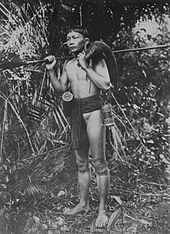
The
Until the development of agriculture approximately 10,000 years ago, Homo sapiens employed a hunter-gatherer method as their sole means of food collection. This involved combining stationary food sources (such as fruits, grains, tubers, and mushrooms, insect larvae and aquatic mollusks) with
As prey
Predators of primates include various species of
Intelligence and cognition
Primates have advanced cognitive abilities: some make tools and use them to acquire food and for social displays;
Tool use and manufacture

In 1960, Jane Goodall observed a chimpanzee poking pieces of grass into a termite mound and then raising the grass to his mouth. After he left, Goodall approached the mound and repeated the behaviour because she was unsure what the chimpanzee was doing. She found that the termites bit onto the grass with their jaws. The chimpanzee had been using the grass as a tool to "fish" or "dip" for termites.[173] There are more limited reports of the closely related bonobo using tools in the wild; it has been claimed they rarely use tools in the wild although they use tools as readily as chimpanzees when in captivity.[174] It has been reported that females, both chimpanzee and bonobo, use tools more avidly than males.[175] Orangutans in Borneo scoop catfish out of small ponds. Over two years, anthropologist Anne Russon observed orangutans learning to jab sticks at catfish to scare them out of the ponds and in to their waiting hands.[176] There are few reports of gorillas using tools in the wild. An adult female western lowland gorilla used a branch as a walking stick apparently to test water depth and to aid her in crossing a pool of water. Another adult female used a detached trunk from a small shrub as a stabilizer during food gathering, and another used a log as a bridge.[177]
The first direct observation of a non-ape primate using a tool in a wild environment occurred in 1988. Primatologist Sue Boinski watched an adult male white-faced capuchin beat a fer-de-lance snake to death with a dead branch.[178] The black-striped capuchin was the first non-ape primate for which routine tool use was documented in the wild; individuals were observed cracking nuts by placing them on a stone anvil and hitting them with another large stone.[179] In Thailand and Myanmar, crab-eating macaques use stone tools to open nuts, oysters and other bivalves, and various types of sea snails.[180] Chacma baboons use stones as weapons; stoning by these baboons is done from the rocky walls of the canyon where they sleep and retreat to when they are threatened. Stones are lifted with one hand and dropped over the side whereupon they tumble down the side of the cliff or fall directly to the canyon floor.[181]
Although they have not been observed to use tools in the wild, lemurs in controlled settings have been shown to be capable of understanding the functional properties of the objects they had been trained to use as tools, performing as well as tool-using haplorhines.[182]
Soon after her initial discovery of tool use, Goodall observed other chimpanzees picking up leafy twigs, stripping off the leaves and using the stems to fish for insects. This change of a leafy twig into a tool was a major discovery. Prior to this, scientists thought that only humans manufactured and used tools, and that this ability was what separated humans from other animals.[173] Chimpanzees have also been observed making "sponges" out of leaves and moss that suck up water.[183] Sumatran orangutans have been observed making and using tools. They will break off a tree branch that is about 30 cm long, snap off the twigs, fray one end and then use the stick to dig in tree holes for termites.[184][185] In the wild, mandrills have been observed to clean their ears with modified tools. Scientists filmed a large male mandrill at Chester Zoo (UK) stripping down a twig, apparently to make it narrower, and then using the modified stick to scrape dirt from underneath its toenails.[186] Captive gorillas have made a variety of tools.[187]
Ecology

Non-human primates primarily live in the
Primate habitats span a range of altitudes: the
Interactions between humans and other primates
Disease transmission
Close interactions between humans and non-human primates (NHPs) can create pathways for the transmission of
Legal and social status

Only humans are recognized as persons and protected in law by the United Nations Universal Declaration of Human Rights.[b] The legal status of NHPs, on the other hand, is the subject of much debate, with organizations such as the Great Ape Project (GAP) campaigning to award at least some of them legal rights.[198] In June 2008, Spain became the first country in the world to recognize the rights of some NHPs, when its parliament's cross-party environmental committee urged the country to comply with GAP's recommendations, which are that chimpanzees, orangutans and gorillas are not to be used for animal experiments.[199][200]
Many species of NHP are kept as pets by humans. The Allied Effort to Save Other Primates (AESOP) estimates that around 15,000 NHPs live as exotic pets in the United States.
Primates are used as
NHPs are kept in zoos around the globe. Historically, zoos were primarily a form of entertainment, but more recently have shifted their focus towards conservation, education and research. GAP does not insist that all NHPs should be released from zoos, primarily because captive-born primates lack the knowledge and experience to survive in the wild if released.[206]
Role in scientific research

Thousands of non-human primates are used around the world in research because of their psychological and physiological similarity to humans.[207][208] In particular, the brains and eyes of NHPs more closely parallel human anatomy than those of any other animals. NHPs are commonly used in preclinical trials, neuroscience, ophthalmology studies, and toxicity studies. Rhesus macaques are often used, as are other macaques, African green monkeys, chimpanzees, baboons, squirrel monkeys, and marmosets, both wild-caught and purpose-bred.[207][209]
In 2005, GAP reported that 1,280 of the 3,100 NHPs living in captivity in the United States were used for experiments.[198] In 2004, the European Union used around 10,000 NHPs in such experiments; in 2005 in Great Britain, 4,652 experiments were conducted on 3,115 NHPs.[210] Governments of many nations have strict care requirements of NHPs kept in captivity. In the US, federal guidelines extensively regulate aspects of NHP housing, feeding, enrichment, and breeding.[211] European groups such as the European Coalition to End Animal Experiments are seeking a ban on all NHP use in experiments as part of the European Union's review of animal testing legislation.[212]
Extinction threats
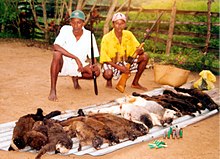
The International Union for Conservation of Nature (IUCN) lists more than a third of primates as critically endangered or vulnerable. About 60% of primate species are threatened with extinction, including: 87% of species in Madagascar, 73% in Asia, 37% in Africa, and 36% in South and Central America.[213] Additionally, 75% of primate species have decreasing populations.[213] Trade is regulated, as all species are listed by CITES in Appendix II, except 50 species and subspecies listed in Appendix I, which gain full protection from trade.[214][215]

Common threats to primate species include

Primates with a large body size (over 5 kg) are at increased extinction risk due to their greater profitability to
In Asia, Hinduism, Buddhism, and Islam prohibit eating primate meat; however, primates are still hunted for food.[220] Some smaller traditional religions allow the consumption of primate meat.[226][227] The pet trade and traditional medicine also increase demand for illegal hunting.[202][228][229] The rhesus macaque, a model organism, was protected after excessive trapping threatened its numbers in the 1960s; the program was so effective that they are now viewed as a pest throughout their range.[219]
In Central and South America forest fragmentation and hunting are the two main problems for primates. Large tracts of forest are now rare in Central America.
There are 21 critically endangered primates, 7 of which have remained on the IUCN's "The World's 25 Most Endangered Primates" list since the year 2000: the silky sifaka, Delacour's langur, the white-headed langur, the gray-shanked douc, the Tonkin snub-nosed monkey, the Cross River gorilla and the Sumatran orangutan.[235] Miss Waldron's red colobus was recently declared extinct when no trace of the subspecies could be found from 1993 to 1999.[236] A few hunters have found and killed individuals since then, but the subspecies' prospects remain bleak.[237]
See also
Footnotes
- ^ a b Although the monophyletic relationship between lemurs and lorisoids is widely accepted, their clade name is not. The term "lemuriform" is used here because it derives from one popular taxonomy that clumps the clade of toothcombed primates into one infraorder and the extinct, non-toothcombed adapiforms into another, both within the suborder Strepsirrhini.[17][18] However, another popular alternative taxonomy places the lorisoids in their own infraorder, Lorisiformes.[16]
- ^ Article 6: Everyone has the right to recognition everywhere as a person before the law.[197]
References
- ^ OCLC 62265494.
- PMID 28429568.
- ^ "Primate". Merriam-Webster Online Dictionary. Merriam-Webster. Retrieved 2008-07-21.
- ^ The Book of Popular Science. 1963. p. 257.
- ^ Chisholm, Hugh, ed. (1911). . Encyclopædia Britannica. Vol. 02 (11th ed.). Cambridge University Press. p. 160.
- ^ a b Weisberger, Mindy (March 23, 2024). "Why don't humans have tails? Scientists find answers in an unlikely place". CNN. Archived from the original on March 24, 2024. Retrieved March 24, 2024.
- ISBN 978-0-297-77895-0
- ^ Definitions of paraphyly vary; for the one used here see e.g. Stace, Clive A. (2010), "Classification by molecules: What's in it for field botanists?" (PDF), Watsonia, 28: 103–122, archived from the original (PDF) on 2011-07-26, retrieved 2010-02-07.
- ISBN 978-1-4443-1492-2.
- ^ ISBN 978-1-118-21145-8.
- ^ ISBN 1-56098-872-X.
- ^ Benton 2005, p. 371.
- ^ Benton 2005, pp. 378–380.
- ^ S2CID 17614597. Archived from the original(PDF) on 2021-02-15. Retrieved 2019-09-24.
- ISBN 978-0-387-78704-6.
- ^ a b Hartwig 2011, pp. 20–21.
- ^ Szalay & Delson 1980, p. 149.
- ^ Cartmill 2010, p. 15.
- ^ Linnaeus, C. (1758). Sistema naturae per regna tria Naturae, secundum classes, ordines, genera, species, cum characteribus differentiis, synonimis locis. Tomus I. Impensis direct. Laurentii Salvii, Holmia. pp. 20–32.
- ^ Linnaeus, C. (1735). Sistema naturae sive regna tria Naturae systematice proposita per classes, ordines, genera, & species. apud Theodorum Haak, Lugduni Batavorum. pp. s.p.
- ^ Blainville, H. (1839). "Nouvelle classification des Mammifères". Annales Françaises et Etrangères d'Anatomie et de Physiologie Appliquées à la Médicine et à l'Histoire Naturelle, 3. pp. 268–269.
- ISBN 978-0-471-08493-8.
- ISBN 0-231-11013-8.
- ISBN 978-0-205-44432-8.
- S2CID 12251814.
- ISBN 0-670-43543-0.
- ISBN 0-231-11012-X.
- PMID 20212104.
- PMID 23166696.
- PMID 21620437.
- PMID 24583291.
- PMID 23874967.
- ^ S2CID 206544776.
- PMID 33972886.
- PMID 20212104.
- PMID 16369958.
- ^ PMID 19860891.
- S2CID 1629316.
- ^ "Scientists Push Back Primate Origins From 65 Million To 85 Million Years Ago". Science Daily. Retrieved 2008-10-24.
- S2CID 4368374.
- PMID 11230540.
- ^ PMID 18245770.
- ^ a b c d Sellers, Bill (2000-10-20). "Primate Evolution" (PDF). University of Edinburgh. pp. 13–17. Archived from the original (PDF) on 2008-10-29. Retrieved 2008-10-23.
- ^ ISBN 978-0-19-517133-4.
- PMID 20188396. Archived from the original(PDF) on 2013-05-17.
- ISBN 978-0-202-01175-2.
- ^ ISBN 978-0-300-12550-4.
- ^ ISBN 1-881173-88-7.
- ^ Shekelle, M. (2005). Evolutionary Biology of Tarsiers. Archived from the original on 2008-09-07. Retrieved 2008-08-22.
- PMID 15851671.
- ScienceNow. Archived from the originalon 2013-06-08. Retrieved 2013-06-07.
- PMID 22699505.
- PMID 22665790.
- PMID 15937103.
- PMID 12832653.
- PMID 10423268.
- S2CID 19293586.
- ^ ISBN 978-0-205-44432-8.
- ISBN 0-13-127836-3.
- ^ IUCN/SSC Primate Specialist Group (1 March 2021). "Primate diversity by region". International Union for the Conservation of Nature.
- S2CID 84957700.
- ^ S2CID 85898043.
- S2CID 23061688.
- S2CID 27900830.
- PMID 29395327.
- . Retrieved 24 January 2018.
- PMID 29368720.
- ^ Briggs, Helen (24 January 2018). "First monkey clones created in Chinese laboratory". BBC News. Retrieved 24 January 2018.
- ^ "Scientists Successfully Clone Monkeys; Are Humans Up Next?". The New York Times. Associated Press. 24 January 2018. Retrieved 24 January 2018.
- ^ ISBN 0-13-127836-3.
- ^ ISBN 0-12-045590-0.
- ^ a b c d e f "Primate". Encyclopædia Britannica Online. Encyclopædia Britannica, Inc. 2008. Retrieved 2008-07-21.
- ^ a b c d e f Myers, P. (1999). ""Primates" (On-line)". Animal Diversity Web. Retrieved 2008-06-03.
- PMID 29609907. Retrieved 29 July 2018.
- ISBN 978-1-4419-8873-7, retrieved 2023-07-30
- ISBN 0-673-52364-0.
- ^ a b White, T. & Kazlev, A. (2006-01-08). "Archonta: Primates". Palaeos. Archived from the original on 2008-05-12. Retrieved 2008-06-03.
- ^ ISBN 0-681-45659-0.
- ISBN 978-0-7216-9382-8.
- PMID 10516564.
- PMID 21953012.
- ^ ISBN 978-0-08-046911-9.
- S2CID 25927323.
- S2CID 84308684.
- S2CID 189798134.
- PMID 810034.
- ISBN 978-0-202-02005-1.
- ^ PMID 28564267.
- S2CID 38220186.
- ^ S2CID 31722173.
- .
- ISBN 0-536-02256-9.
- ^ ISBN 0-536-74364-9.
- ISBN 9780313300905.
- PMID 15888411.
- PMID 2051127. Retrieved 2008-06-16.
- ^ .
- S2CID 739130.
- S2CID 18223362.
- ^ Bowdler, Neil (21 December 2010). "Neanderthal family found cannibalised in cave in Spain". BBC News.
- ^ Bowdler, Neil (2 June 2011). "Ancient cave women 'left childhood homes'". BBC News. Retrieved 2 June 2011.
- S2CID 205225222.
- ISBN 978-0-19-517133-4.
- ISBN 978-0-19-517133-4.
- ^ Wiens, Frank (2002). Behavior and ecology of wild slow lorises (Nycticebus coucang): social organization, infant care system, and diet (PDF) (Ph.D. thesis). Bayreuth University. pp. 31–32. Archived from the original (PDF) on 9 March 2012.
- ISBN 978-0-19-517133-4.
- ISBN 978-0521555364.
- ^ S2CID 46626761.
- S2CID 10954608.[permanent dead link]
- S2CID 46604532.
- ^ ISBN 0-9648825-0-7.
- S2CID 13549970.
- ^ ISBN 0-13-127836-3.
- ^ Smuts, B.B., Cheney, D.L. Seyfarth, R.M., Wrangham, R.W., & Struhsaker, T.T. (Eds.) (1987). Primate Societies. Chicago: University of Chicago Press for articles on the structure and function of various primate societies.
- ^ Zimmer, Carl (16 November 2023). "Scientists Find First Evidence That Groups of Apes Cooperate - Some bonobos are challenging the notion that humans are the only primates capable of group-to-group alliances". The New York Times. Archived from the original on 16 November 2023. Retrieved 17 November 2023.
- from the original on 17 November 2023. Retrieved 17 November 2023.
- ISBN 978-0-521-81633-5.
- ^ ISBN 978-0-521-81633-5.
- ISBN 0-674-00722-0.
- ^ ISBN 0-226-06340-2.
- PMID 12631698. Retrieved 2008-07-23.
- ISBN 0-08-044299-4. Archived from the original(PDF) on 2008-09-10.
- ^ PMID 17470779.
- S2CID 205478149.
- S2CID 1586657.
- PMID 22319094.
- JSTOR 4536401.
- ^ "Black howler monkey". Smithsonian's National Zoo & Conservation Biology Institute. 25 April 2016. Retrieved 2016-07-10.
- S2CID 30539292.
- S2CID 53165940.
- S2CID 85262432.
- PMID 27957536.
- PMID 28076426.
- PMID 34582737.
- S2CID 7403772.
- PMID 23898180.
- JSTOR 4535195.
- S2CID 196589387.
- S2CID 25301078.
- ^ Mintz, Zoe (14 January 2014). "Humans And Primates Burn 50 Percent Fewer Calories Each Day Than Other Mammals". www.ibtimes.com. IBT Media Inc. Retrieved 2014-01-14.
- PMID 18495681.
- PMID 8351513.
- PMID 3113259. Archived from the originalon 2012-06-28.
- PMID 1937286.
- ^ Hiller, C. (2000). "Theropithecus gelada". Animal Diversity Web. Retrieved 2008-08-08.
- ISBN 0-8135-3236-1.
- ISBN 0-674-11649-6.
- ^ Guernsey, Paul. "WHAT DO CHIMPS EAT?". All About Wildlife. Archived from the original on 2019-11-18. Retrieved 2013-04-22.
- S2CID 10063791.
- ^ Rafert, J.; Vineberg, E.O. (1997). "Bonobo Nutrition – relation of captive diet to wild diet" (PDF). Bonobo Husbandry Manual. American Association of Zoos and Aquariums. Archived from the original (PDF) on 2012-04-25.
- S2CID 32622605.
- S2CID 6708310.
- PMID 15699220.
- PMID 12691181.
- ^ Earliest agriculture in the Americas Archived 3 June 2010 at the Wayback Machine Earliest cultivation of barley Archived 16 February 2007 at the Wayback Machine Earliest cultivation of figs Archived 2 June 2006 at the Wayback Machine, retrieved 19 February 2007
- PMID 19656837.
- PMID 9299882.
- ISBN 978-0-226-53172-4.
- PMID 2157651.
- PMID 9642788.
- S2CID 8190458.
- PMID 10739311.
- PMID 15306289.
- S2CID 4424086.
- S2CID 21042762.
- PMID 11459163.
- PMID 9642782.
- PMID 11561924.
- ISBN 978-0-19-510624-4.
- ^ S2CID 16702785.
- ^ PMID 21357224. Archived from the original(PDF) on 2011-10-03. Retrieved 2011-07-04.
- ^ a b "Toolmaking". The Jane Goodall Institute. Retrieved 2013-08-01.
- ^ "Bonobos". ApeTag. 2010. Archived from the original on 2013-11-02. Retrieved 2013-08-03.
- ^
Gruber, T.; Clay, Z.; Zuberbühler, K. (2010). "A comparison of bonobo and chimpanzee tool use: evidence for a female bias in the Pan lineage" (PDF). Animal Behaviour. 80 (6): 1023–1033. S2CID 14923158.
- Wired. Retrieved 2013-08-05.
- PMID 16187795.
- S2CID 84653622.
- S2CID 16222308.
- S2CID 22384150.
- S2CID 4149862.
- ISBN 978-3-642-02724-6.
- S2CID 86473603.
- ^ "Sumatran orangutans". OrangutanIslands.com. Archived from the original on 2013-11-26. Retrieved 2013-08-02.
- S2CID 27180148.
- ^ Gill, Victoria (22 July 2011). "Mandrill monkey makes 'pedicuring' tool". BBC. Retrieved 2013-08-11.
- ^ Vancatova, M. (2008). "Gorillas and Tools – Part I". Retrieved 2013-08-04.
- ISBN 978-0-691-14069-8.
- PMID 7644506.
- ISBN 978-0-19-517133-4.
- S2CID 23931368.
- ISBN 978-0-226-73635-8.
- ISBN 978-0226767161.
- S2CID 5108827.
- ISBN 978-0-19-517133-4.
- PMID 3551307. Retrieved 2008-08-11.
- ^ "The Universal Declaration of Human Rights". United Nations. 1948. Archived from the original on 2014-12-08. Retrieved 2008-12-02.
- ^ a b Cavalieri, P. & Singer, P. "Declaration on Great Apes". Great Ape Project. Archived from the original on 2008-08-20. Retrieved 2008-06-16.
- ^ Glendinning, L. (26 June 2008). "Spanish parliament approves 'human rights' for apes". The Guardian. Retrieved 2008-11-10.
- ^ Singer, P. (18 July 2008). "Of great apes and men". The Guardian. Retrieved 2008-11-10.
- ^ Mott, M. (16 September 2003). "The Perils of Keeping Monkeys as Pets". National Geographic. Archived from the original on 2013-06-08. Retrieved 2013-02-06.
- ^ .
- ^ "IPPL News: The US Pet Monkey Trade". International Primate Protection League. 2003. Archived from the original on 2008-07-25. Retrieved 2008-08-04.
- ^ Bushnell, D. (1958). "The Beginnings of Research in Space Biology at the Air Force Missile Development Center, 1946–1952". History of Research in Space Biology and Biodynamics. NASA. Archived from the original on 2008-01-25. Retrieved 2008-08-18.
- ^ Blumenthal, D. (1987-06-17). "Monkeys as Helpers To Quadriplegics At Home". The New York Times. Retrieved 2008-10-08.
- ISBN 978-1-4422-1957-1.
- ^ a b "The supply and use of primates in the EU". European Biomedical Research Association. 1996. Archived from the original on 2012-01-17. Retrieved 2008-08-18.
- PMID 11170892.
- S2CID 6743973.
- ISBN 0-10-168772-9. Retrieved 2008-06-16.
- ^ "Nonhuman Primates: Research Animals". Animal Welfare Information Center. United States Department of Agriculture. Archived from the original on 2008-10-03. Retrieved 2008-07-14.
- ^ "Directive 86/609". European Coalition to End Animal Experiments. Archived from the original on 2008-09-29. Retrieved 2008-10-08.
- ^ PMID 28116351.
- ^ IFAW (2005). Born to be wild: Primates are not pets (PDF). International Fund for Animal Welfare. Archived from the original (PDF) on 2011-07-26. Retrieved 2011-02-26.
- ^ CITES (2010-10-14). "Appendices I, II and III". Convention on International Trade in Endangered Species of Wild Fauna and Flora. Retrieved 2012-04-02.
- ISBN 0-9512562-4-6.
- ^ S2CID 13494366.
- ^ a b Mittermeier, R. A. & Cheney, D. L. (1987). "Conservation of primates and their habitats". In Smuts, B. B.; Cheney, D. L.; Seyfarth, R. M.; Wrangham, R. W. & Struhsaker, T. T. (eds.). Primate Societies. Chicago: University of Chicago Press. pp. 477–490.
- ^ a b Southwick, C. H. & Siddiqi, M. F. (2001). "Status, conservation and management of primates in India" (PDF). Envis Bulletin: Wildlife and Protected Areas. 1 (1): 81–91. Archived from the original (PDF) on 2008-10-01. Retrieved 2008-08-04.
- ^ ISBN 978-0-226-11637-2.
- .
- PMID 11075706.
- ^ PMID 34261280.
- .
- .
- ^ Choudhury, A. (2001). "Primates in Northeast India: an overview of their distribution and conservation status" (PDF). Envis Bulletin: Wildlife and Protected Areas. 1 (1): 92–101. Archived from the original (PDF) on 2008-10-01. Retrieved 2008-08-04.
- S2CID 30384142.
- ^ Nijman, V. (2004). "Conservation of the Javan gibbon Hylobates moloch: population estimates, local extinction, and conservation priorities" (PDF). The Raffles Bulletin of Zoology. 52 (1): 271–280. Archived from the original (PDF) on 2008-09-10. Retrieved 2008-08-04.
- S2CID 32472118.
- .
- ISBN 0-306-47696-7.
- JSTOR 2404743.
- ISBN 978-0-306-47696-9.
- ISBN 978-0-412-05581-2.
- ISBN 978-1-934151-34-1.
- S2CID 84336872.
- S2CID 861418.
Literature cited
- Benton, Michael J. (2005). "Chapter 3: Primate evolution". Vertebrate palaeontology. Wiley-Blackwell. ISBN 978-0-632-05637-8. Retrieved 2011-07-10.
- Cartmill, M. (2010). "Primate Classification and Diversity". In Platt, M.; Ghazanfar, A (eds.). Primate Neuroethology. Oxford University Press. pp. 10–30. ISBN 978-0-19-532659-8.
- Hartwig, W. (2011). "Chapter 3: Primate evolution". In Campbell, C. J.; Fuentes, A.; MacKinnon, K. C.; Bearder, S. K.; Stumpf, R. M (eds.). Primates in Perspective (2nd ed.). Oxford University Press. pp. 19–31. ISBN 978-0-19-539043-8.
- Szalay, F.S.; Delson, E. (1980). Evolutionary History of the Primates. OCLC 893740473.
Further reading
- David J. Chivers; Bernard A. Wood; Alan Bilsborough, eds. (1984). Food Acquisition and Processing in Primates. New York & London: Plenum Press. ISBN 0-306-41701-4.
External links
- Primate at Curlie
- Primate Info Net
- Primates at Animal Diversity Web
- Primate Research Institute, Kyoto University
- High-Resolution Cytoarchitectural Primate Brain Atlases
- EUPRIM-Net: European Primate Network
- PrimateImages: Natural History Collection
- Interactive views of various primate skeletons at eSkeletons.org (associated with the University of Texas at Austin)
- Tree of Life web project

